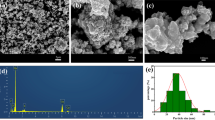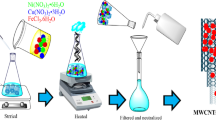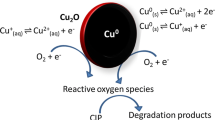Abstract
The objective of this study is to investigate and understand the oxidizing properties of a manganese oxide, specifically synthetic cryptomelane (KMn8O16) and its derivatives, in aqueous solution. Ciprofloxacin (CIP), a commonly used fluoroquinolone antibiotic, was used as the probe. Synthetic cryptomelane, known as octahedral molecular sieves (OMS-2), was synthesized, and its derivatives were prepared by adding transition metal oxides, V2O5 or MoO3, as dopants during synthesis. The solids were characterized by x-ray powder diffraction (XRD), SEM–energy-dispersive spectrometry (SEM-EDX), x-ray photoelectron spectroscopy (XPS), Fourier transform infrared spectra (FTIR), Raman spectra, and N2-Brunauer-Emmett-Teller method. Degradation of CIP by different doped OMS-2 was carried out. Process conditions were optimized using response surface methodology (RSM). XRD patterns indicated the crystal phase of regular and doped OMS-2 as the cryptomelane type. Presence of the dopants in doped cryptomelane was confirmed by SEM-EDX and XPS. FTIR and Raman results suggested that the dopants were substituted into the framework in place of manganese. SEM images, XRD analysis, and surface area analysis of doped OMS-2 indicated decreased particle size, decreased crystallinity, and increased surface area compared to regular OMS-2. Higher oxidizing reactivity of doped OMS-2 was also observed with increased CIP removal rates from aqueous solution. The enhancement of reactivity may be due to the increase of surface areas. Nine percent Mo/OMS-2, the most effective oxidant of all synthesized derivatives, was selected for optimization study. Favorable treatment conditions were obtained using RSM at pH 3 with molar ratio [9 % Mo/OMS-2]/[CIP] ≥ 50. Under such conditions, more than 90 % CIP can be removed in 30 min. The degradation kinetics was modeled by a modified first order rate with introduction of a retardation factor-α (R 2 > 0.98). Analysis of degradation products indicated that oxidation takes place mainly on the piperazine ring of CIP.










Similar content being viewed by others

References
Abecassis-Wolfovich M, Jothiramalingam R, Landau M, Herskowitz M, Viswanathan B, Varadarajan T (2005) Cerium incorporated ordered manganese oxide OMS-2 materials: improved catalysts for wet oxidation of phenol compounds. Appl Catal Environ 59:91–98
Cai J, Liu J, Willis WS, Suib SL (2001) Framework doping of iron in tunnel structure cryptomelane. Chem Mater 13:2413–2422
Cerrato JM, Hochella MF Jr, Knocke WR, Dietrich AM, Cromer TF (2010) Use of XPS to identify the oxidation state of Mn in solid surfaces of filtration media oxide samples from drinking water treatment plants. Environ Sci Technol 44:5881–5886
DeGuzman RN, Shen YF, Neth EJ, Suib SL, O'Young CL, Levine S, Newsam JM (1994) Synthesis and characterization of octahedral molecular sieves (OMS-2) having the hollandite structure. Chem Mater 6:815–821
DeWitte B, Dewulf J, Demeestere K, Vyvere VVD, Wispelaere PD, Langenhove HVL (2008) Ozonation of ciprofloxacin in water: HRMS identification of reaction products and pathways. Environ Sci Technol 42:4889–4895
Domagala JM (1994) Structure-activity and structure-side-effect relationships for the quinolone antibacterials. J Antimicrob Chemother 33:685–706
Ebert I, Bachmann J, Kühnen U, Küster A, Kussatz C, Maletzki D, Schlüter C (2011) Toxicity of the fluoroquinolone antibiotics enrofloxacin and ciprofloxacin to photoautotrophic aquatic organisms. Environ Toxicol Chem 30:2786–2792
Frederickson L Jr, Hausen D (1963) Infrared spectra-structure correlation study of vanadium-oxygen compounds. Anal Chem 35:818–827
Gao T, Glerup M, Krumeich F, Nesper R, Fjellvåg H, Norby P (2008) Microstructures and spectroscopic properties of cryptomelane-type manganese dioxide nanofibers. J Phys Chem C 112:13134–13140
Gros M, Petrovic M, Barcelo D (2008) Tracing pharmaceutical residues of different therapeutic classes in environmental waters by using liquid chromatography/quadrupole-linear ion trap mass spectrometry and automated library searching. Anal Chem 81:898–912
Hardcastle FD, Wachs IE (1991) Determination of vanadium-oxygen bond distances and bond orders by Raman spectroscopy. J Phys Chem 95:5031–5041
Hu B, Chen C, Frueh SJ, Jin L, Joesten R, Suib SL (2010) Removal of aqueous phenol by adsorption and oxidation with doped hydrophobic cryptomelane-type manganese oxide (K-OMS-2) nanofibers. J Phys Chem C 114:9835–9844
King'ondu CK, Opembe N, Chen C, Ngala K, Huang H, Iyer A, Garcés HF, Suib SL (2011) Manganese oxide octahedral molecular sieves (OMS–2) multiple framework substitutions: a new route to OMS–2 particle size and morphology control. Adv Funct Mater 21:312–323
Kolpin DW, Furlong ET, Meyer MT, Thurman EM, Zaugg SD, Barber LB, Buxton HT (2002) Pharmaceuticals, hormones, and other organic wastewater contaminants in US streams, 1999–2000: a national reconnaissance. Environ Sci Technol 36:1202–1211
Laha S, Luthy R (1990) Oxidation of aniline and other primary aromatic amines by manganese dioxides. Environ Sci Technol 24:363–373
Lemus MA, López T, Recillas S, Frías D, Montes M, Delgado J, Centeno M, Odriozola J (2008) Photocatalytic degradation of 2,4-dichlorophenoxyacetic acid using nanocrystalline cryptomelane composite catalysts. J Mol Catal Chem 281:107–112
Lin K, Liu W, Gan J (2009) Reaction of tetrabromobisphenol A (TBBPA) with manganese dioxide: kinetics, products, and pathways. Environ Sci Technol 43:4480–4486
Liu C, Zhang L, Li F, Wang Y, Gao Y, Li X, Cao W, Feng C, Dong J, Sun L (2009) Dependence of sulfadiazine oxidative degradation on physicochemical properties of manganese dioxides. Ind Eng Chem Res 48:10408–10413
Matocha CJS, Amonette DL, Kukkadapu JE, Ravi K (2001) Kinetics and mechanism of birnessite reduction by catechol. Soil Sci Soc Am J 65:58–66
Peluso MA, Gambaro LA, Pronsato E, Gazzoli D, Thomas HJ, Sambeth JE (2008) Synthesis and catalytic activity of manganese dioxide (type OMS-2) for the abatement of oxygenated VOCs. Catal Today 133:487–492
Polverejan M, Villegas JC, Suib SL (2004) Higher valency ion substitution into the manganese oxide framework. J Am Chem Soc 126:7774–7775
Robinson AA, Belden JB, Lydy MJ (2005) Toxicity of fluoroquinolone antibiotics to aquatic organisms. Environ Toxicol Chem 24:423–430
Rubert KF IV, Pedersen JA (2006) Kinetics of oxytetracycline reaction with a hydrous manganese oxide. Environ Sci Technol 40:7216–7221
Seguin L, Figlarz M, Cavagnat R, Lassègues JC (1995) Infrared and Raman spectra of MoO3 molybdenum trioxides and MoO3 · xH2O molybdenum trioxide hydrates. Spectrochim Acta A Mol Biomol Spectrosc 51:1323–1344
Shin JY, Cheney MA (2004) Abiotic transformation of atrazine in aqueous suspension of four synthetic manganese oxides. Colloids Surf Physicochem Eng Aspect 242:85–92
Sriskandakumar T, Opembe N, Chen CH, Morey A, King'ondu C, Suib SL (2009) Green decomposition of organic dyes using octahedral molecular sieve manganese oxide catalysts. J Phys Chem A 113:1523–1530
Stone AT (1987a) Microbial metabolites and the reductive dissolution of manganese oxides: oxalate and pyruvate. Geochim Cosmochim Acta 51:919–925
Stone AT (1987b) Reductive dissolution of manganese(III/IV) oxides by substituted phenols. Environ Sci Technol 21:979–988
Sun L, Cao Q, Hu B, Li J, Hao J, Jing G, Tang X (2011) Synthesis, characterization and catalytic activities of vanadium–cryptomelane manganese oxides in low-temperature NO reduction with NH3. Appl Catal Gen 393:323–330
Toupin M, Brousse T, Bélanger D (2002) Influence of microstructure on the charge storage properties of chemically synthesized manganese dioxide. Chem Mater 14:3946–3952
Tsilomelekis G, Boghosian S (2011) In situ Raman and FTIR spectroscopy of molybdenum (VI) oxide supported on titania combined with 18O/16O exchange: molecular structure, vibrational properties, and vibrational isotope effects. J Phys Chem C 115:2146–2154
Wang Y, Stone AT (2006) The citric acid–MnIII, IVO2 (birnessite) reaction. Electron transfer, complex formation, and autocatalytic feedback. Geochim Cosmochim Acta 70:4463–4476
Wang P, He YL, Huang CH (2010) Oxidation of fluoroquinolone antibiotics and structurally related amines by chlorine dioxide: reaction kinetics, product and pathway evaluation. Water Res 44:5989–5998
Xiao X, Zeng X, Lemley AT (2010) Species-dependent degradation of ciprofloxacin in a membrane anodic Fenton system. J Agric Food Chem 58:10169–10175
Xu L, Xu C, Zhao M, Qiu Y, Sheng GD (2008) Oxidative removal of aqueous steroid estrogens by manganese oxides. Water Res 42:5038–5044
Zhang H, Huang CH (2003) Oxidative transformation of triclosan and chlorophene by manganese oxides. Environ Sci Technol 37:2421–2430
Zhang H, Huang C (2005) Oxidative transformation of fluoroquinolone antibacterial agents and structurally related amines by manganese oxide. Environ Sci Technol 39:4474–4483
Zhang T, Zhang X, Ng J, Yang H, Liu J, Sun DD (2011) Fabrication of magnetic cryptomelane-type manganese oxide nanowires for water treatment. Chem Commun 47:1890–1892
Acknowledgments
This study was funded in part by the College of Human Ecology, Cornell University, and in part by the Cornell University Agricultural Experiment Station federal formula funds, project No. NYC-329829 (W-1045), received from the Cooperative State Research, Education, and Extension Service, US Department of Agriculture. Any opinions, findings, conclusions, or recommendations expressed in this publication are those of the author(s) and do not necessarily reflect the views of the U.S. Department of Agriculture. This work made use of the SEM-EDX, XPS, Raman, and FTIR facilities of the Cornell Center for Materials Research with support from the National Science Foundation Materials Research Science and Engineering Centers program (DMR 1120296). The authors would also like to thank Prof. Ulrich Wiesner and his graduate student, Hiroaki Sai, for assistance in surface area analysis.
Author information
Authors and Affiliations
Corresponding author
Additional information
Responsible editor: Philippe Garrigues
Electronic supplementary material
Below is the link to the electronic supplementary material.
ESM 1
(PDF 381 kb)
Rights and permissions
About this article
Cite this article
Xiao, X., Sun, SP., McBride, M.B. et al. Degradation of ciprofloxacin by cryptomelane-type manganese(III/IV) oxides. Environ Sci Pollut Res 20, 10–21 (2013). https://doi.org/10.1007/s11356-012-1026-6
Received:
Accepted:
Published:
Issue Date:
DOI: https://doi.org/10.1007/s11356-012-1026-6



